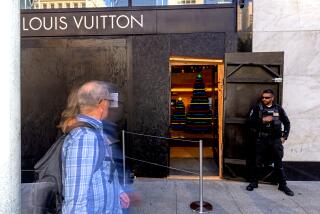How the nation’s largest security-guard firm adapts to changing threats
- Share via
At a time of heightened concern about terrorism and workplace violence, one person often is overlooked: the private security guard.
The nation’s largest provider of guards, Allied Universal, was created this week with the merger of AlliedBarton Security Services and Universal Services of America.
The newly merged firm, with dual headquarters in Santa Ana and Conshohocken, Pa., has 140,000 employees and annual revenue of $4.5 billion.
The firm’s guards are on duty at commercial office buildings, stores, universities, defense plants, banks and many other locations, including the Los Angeles Times building in downtown Los Angeles.
Allied Universal also claims to be the largest provider of security guards — the company prefers the term “security professionals” — to shopping malls nationwide.
Steve Jones, 47, is Allied Universal’s chief executive, and we asked him to describe how his business and his clients’ security needs have evolved with the growing safety threats. Here’s an edited excerpt:
What are your employees’ main duties?
It’s a lot more than just standing in the lobby and saying “good morning.” First and foremost is access control — who should be allowed to come and go from the building. It’s customer service and visitor management. We also are the deterrent for any type of criminal activity and any type of graffiti or property damage.
We’re also the first responders in the event of any emergency, whether it’s a fire alarm or earthquake or any type of a more serious incident. If anyone gets injured or there are any incidents that occur on the property, we’ll manage that.
Some of the movies have painted security guards in a bad light, and there’s hundreds of thousands of security officers across the country that truly are the first line of defense and do so much. I can’t tell you how many lives we’ve saved or how many purses or wallets we’ve found or emergencies and disasters that we’ve responded to. They’re unsung heroes.
Why do you think that image has endured?
You remember Barney Fife on the old “Andy Griffith Show?” It’s the old Barney Fife image. It’s been portrayed [that way] in movies and everywhere else. They don’t portray the guard as catching the suspects, it’s always the guard is half-asleep. That image just carried on.
But look at the events of Sept. 11 and the security professionals who were there evacuating people from the buildings, and it’s continued with workplace violence incidents. We’re securing buildings, we’re keeping people out of harm’s way, we’re responding to injured people.
What are the main qualifications for this kind of work?
We require a high school diploma or GED, and they have to pass a background check and a drug test — that would be minimum requirements. Our ideal candidate also would have some college, some military experience is preferred, some solid work experience.
Our ideal employee is either a retired professional and they’re doing to this to start a second career or an individual who wants to get into law enforcement and uses this as a stepping stone, or individuals coming out of the military and looking for opportunities to leverage their security experience learned in the military.
How much do they typically earn for this work in Southern California?
Probably our average in Los Angeles is $13 to $15 an hour. The officers have an opportunity, if they work over 40 hours, to make overtime. What’s a security officer making per year? It’s probably $35,000 to $45,000 a year for the entry-level security officer.
How much have their duties changed in the last 20 or 30 years?
The events of Sept. 11 changed everything. And the ongoing threat of terrorism now has dramatically changed the industry. If something major happens, we’re trying to keep people out of harm’s way and secure the facility.
When you look at the occurrences of workplace violence and active shooters these days, there’s almost one a day. Compared to 20 years ago that’s something we’ve seen dramatically increase. We are constantly reminding our security professionals to remain vigilant, and we’re notifying them of information we get from a variety of law enforcement services, whether it’s the police or the Department of Homeland Security or the FBI.
All of this is taught in your training?
There’s an entire course on the threat of terrorism; 20 years ago there wasn’t a course. Now it’s in their initial orientation. The focus 20 years ago was mainly access control, responding to emergencies and customer service. It’s significantly more today.
What was behind the merger that created Allied Universal?
Both businesses were doing very well, both were growing. The merger provides size and scale to deploy additional resources when needed. We now have the ability to deploy thousands of people to our customers. What really drove it was the opportunity to strengthen both organizations.
You also provide security equipment and services?
We have an electronic security systems division that provides cameras and access-control systems and we monitor alarms. We have another technology where we provide remote video monitoring, where a computer uses a program to analyze camera footage and look for incidents. Instead of the old days where humans would have to try to watch 20 or 30 cameras, now the computer analyzes the cameras and tells us when someone does something that’s in violation.
What percentage of your total revenue comes from this technology?
It’s less than 10% right now but it’s growing 100%-plus a year.
For more business news, follow James F. Peltz on Twitter: @PeltzLATimes
More to Read
Inside the business of entertainment
The Wide Shot brings you news, analysis and insights on everything from streaming wars to production — and what it all means for the future.
You may occasionally receive promotional content from the Los Angeles Times.











